Adding a banana leaf plant to your landscape can transport you to the tropics every time you look outside. With their huge, lush leaves, these plants make a dramatic statement in any garden. However, with so many varieties to choose from, it can be tricky to select the right banana leaf plant for your particular space. In this article, I’ll walk you through the key factors to consider when picking out a banana leaf plant, so you can make the best choice for your yard.
First, let’s start with a quick overview of these amazing plants. Banana leaf plants belong to the genus Musa. They are native to warm, humid tropical regions, but some varieties can tolerate cooler climates. These plants are grown for their fruit, but also make excellent ornamental plants thanks to their beautiful, supersized leaves. The leaves can reach up to 9 feet long and 2 feet wide!
There are dozens of banana leaf plant species and cultivars to choose from They range in height from 4-30 feet when fully grown Some have gorgeous pink, red, or purplish colored leaves. Others have variegated foliage. The diversity among banana leaf plant varieties allows you to select one that fits your climate and landscape design needs.
Factors to Consider When Selecting a Banana Leaf Plant
Now that you know the basics about banana leaf plants let’s explore the key factors to weigh when choosing one for your yard
Climate and Hardiness
Since banana leaf plants thrive in tropical environments, the first thing to consider is your climate. Selecting a variety that is suited for your USDA Plant Hardiness Zone is crucial
-
Cold hardy varieties like Musa Basjoo can survive temperatures down to -10°F, making them a good option for northern gardeners.
-
If you live in zone 9 or above, you can grow less cold tolerant types like Musa acuminata.
-
Potted banana leaf plants can be overwintered indoors in colder climates.
Mature Size
Banana leaf plants range hugely in their mature dimensions. Make sure to select a variety that will fit the space you have available.
-
Dwarf banana leaf plant varieties reach 5-7 feet tall and wide. Great for containers.
-
Many popular types grow 10-15 feet tall and wide – perfect for mediums spaces.
-
Giant varieties can hit 20-30 feet tall! Reserve these for large open yards.
Growth Rate
Some banana leaf plants grow rapidly, while others put on leaves at a more leisurely pace. Growth rate is another factor to consider.
-
Fast growing types can gain several feet of height per year. They make a bold statement quickly.
-
Slow growing varieties may take a few years to reach maturity. These are great if you want a more gradual effect.
Leaf Color
Beyond green, banana leaf plant leaves come in many gorgeous hues. Pick a variety with your preferred leaf color.
-
Green leaf varieties offer a classic tropical look.
-
Red banana leaf plant cultivars provide striking contrast.
-
Pink and purplish types give a unique and elegant vibe.
-
Variegated options blend multiple colors for added interest.
Fruit Production
Some banana leaf plants bear edible fruit, while others do not. Decide if fruit production is one of your goals.
-
Varieties like Musa acuminata produce tasty fruit.
-
Many ornamental banana leaf plants do not make edible bananas.
-
Even fruiting kinds can take up to two years to bear fruit.
Maintenance Needs
Factor in the ongoing care your banana leaf plant will require. This impacts the variety you select.
-
Fast growing types need frequent watering and fertilizing to look their best.
-
Disease resistant varieties are easier to care for in the long run.
-
Smaller banana leaf plants require less pruning than giant varieties.
Best Practices for Incorporating Banana Plants into Your Landscape
Once you’ve picked the perfect banana leaf plant for your yard, follow these tips to successfully incorporate it:
-
Give it plenty of space to grow to its full size. Don’t plant it too close to buildings or other plants.
-
Place it in a sunny, sheltered spot. Banana leaf plants need 6+ hours of direct sun daily.
-
Prepare the soil well with lots of compost and organic matter to retain moisture.
-
Stake the plant if needed to provide support in windy conditions.
-
Apply a thick mulch layer around the plant to conserve soil moisture and suppress weeds.
-
Protect it over winter if you live in a climate with freezes. Move potted plants indoors.
Enjoy the Tropical Vibes!
Adding a banana leaf plant to your outdoor space brings energy and excitement. By considering the factors outlined and pairing them with your landscape goals, you can pick the variety that’s just right for you. Follow best practices when siting and caring for your plant. Soon you’ll be enjoying tropical vibes whenever you gaze at its huge, elegant leaves. The right banana leaf plant can transform your yard into an exotic paradise.
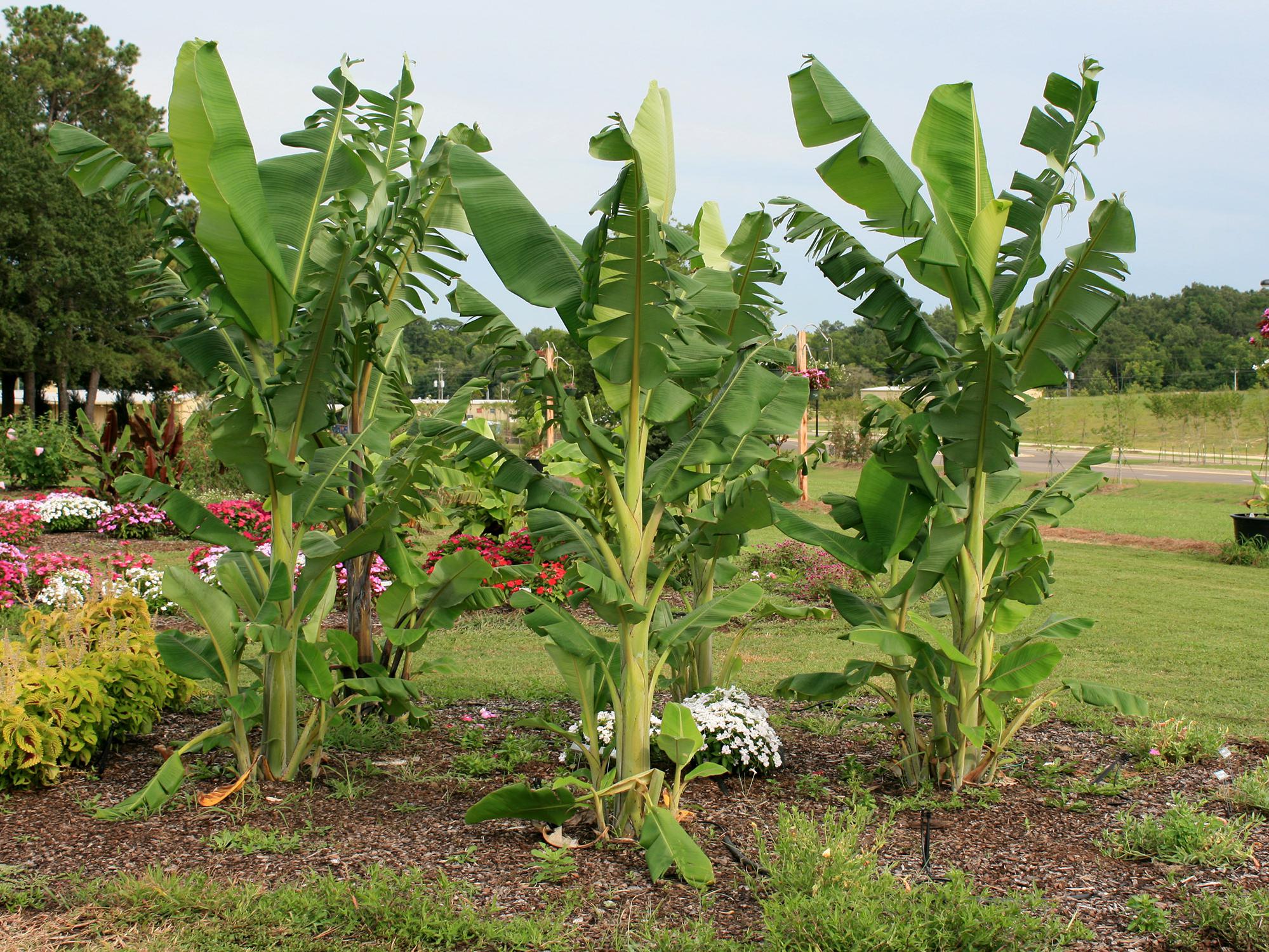
Tropical Flare for Pots, Patios, Borders, & Yards
With new cultivars improving ornamental aesthetics, cold hardiness, disease resistances, and fruit-yield, we’re long overdue to talk about the tropical banana plant. We’ll discuss each variety in detail below, but let’s get the universal traits out of the way first:
- Fast-growing: All Banana trees on this list grow extremely fast, some even reaching maturity in a single year. That means 3, 5, even 10 feet in the time it takes my snake plant to grow a new leaf!
- Sun / Heat loving: While they can definitely grow well in shade, full sun will deliver the best results. Sun and heat helps keep moisture from sitting on the large leaves, which can lead to fungal issues.
- Watering: Must have well-draining soil, mound appropriately when planting in-ground. You should be watering nearly once a day after planting, but can reduce to just enough to keep the soil moist once established.
- Fertilizer: Use a balanced (13-13-13) fertilizer in the spring, and a high-potassium fertilizer (The ‘K’ in N-P-K) in the summer.
- Self-Pollinating: All edible banana plants can produce fruit by themselves, no second plant necessary.
At our garden center, we stock a good mix of both Ornamental & edible banana plants. Ornamentals are the showier varieties, grown for striking foliage. Edibles typically have accented traits for fruit production. Whatever you choose, just know the Louisiana climate makes them easy to grow but difficult to harvest. Have reasonable expectations when choosing in-ground tropicals, where the occasional flower or even fruit is a happy surprise!
Our most popular ornamental banana, the Red Maurelii demands your attention by producing a fantastic gradient of colors on their foliage. Purples morph into subdued greens and vibrant reds, with each leaf being slightly different from the last. When mature, the red trunk begins to stand out as its own point of interest.
Growth: 12-15ft tall by 6-10ft wideCold Hardiness: 20-30 degrees
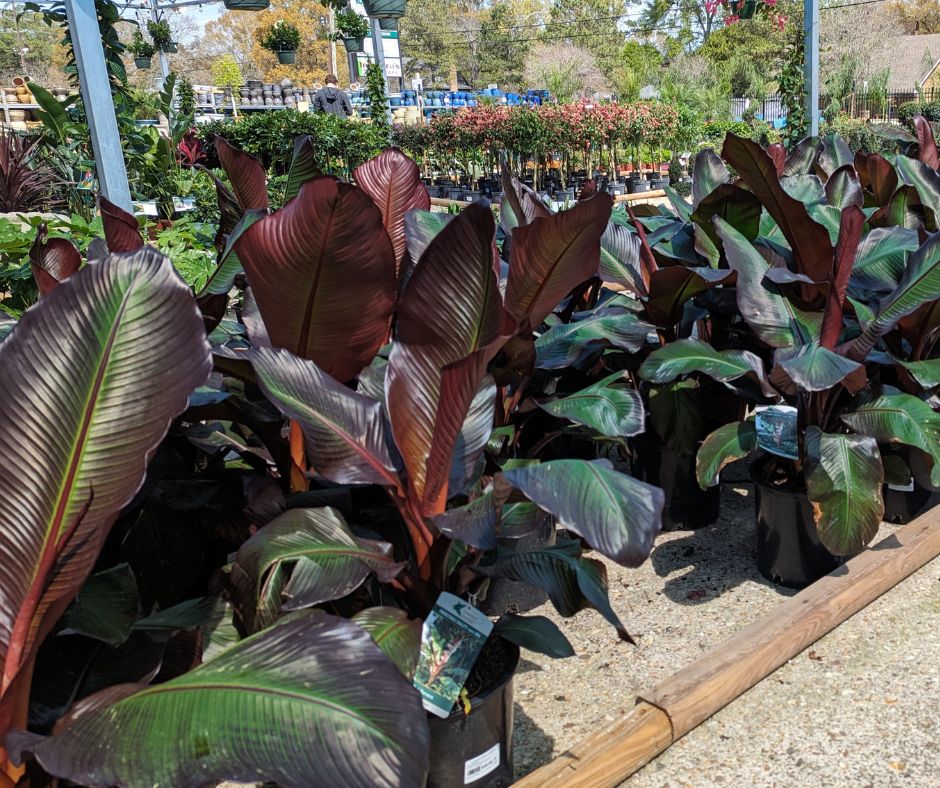
(Musa acuminata ‘Little Prince’)
Little prince is the perfect name for this beautiful, truly-dwarfed plant. Maxing out at just 2-3 ft tall, it can fit in almost any container. Easily bring it inside for cold protection, or just keep it indoors year-round for a beautiful addition to your plant shelf. The foliage of little prince is mostly a classic green, but you’ll see blotchy dark-reds appear as it matures, more-so when getting enough sunlight.Growth: 24-30 in tall, similar widthCold Hardiness: 30-40 degrees

The classic banana plant we all know and love! Under the right conditions, these plants can get MASSIVE. You won’t get much color, but there’s nothing wrong with enjoying a green leaf when it’s 3 ft long! The fruit has a sweet taste, ready to eat right after ripening. However, Louisiana gardeners may have trouble due to our typical winter temperatures. Be happy with the plant alone, but be ecstatic if you’re lucky enough to eat some of its fruit!
Growth: 12-20 ft tall, 8-15 ft wideCold Hardiness: 40 degrees
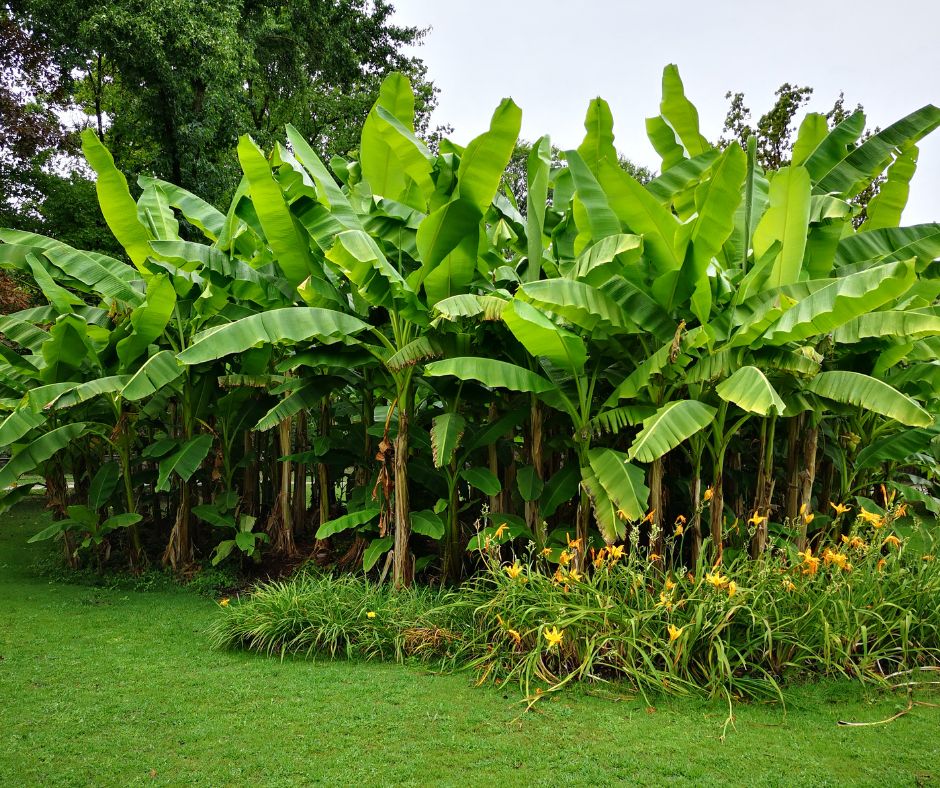
Named after its ability to produce two large heads of fruit in its second fruiting cycle. Double Mahoi is a mutation of the Dwarf Cavendish banana. Although its cold hardiness leaves some to be desired, the plant matures at only 6-8 ft tall. This means you can easily grow Double Mahoi in a container, and bring it inside for any cold-snaps. With a bit of planning, you’ll have better chances than ever of home-grown bananas.
Growth: 6-8 ft tall, similar widthCold Hardiness: 30-40 degrees
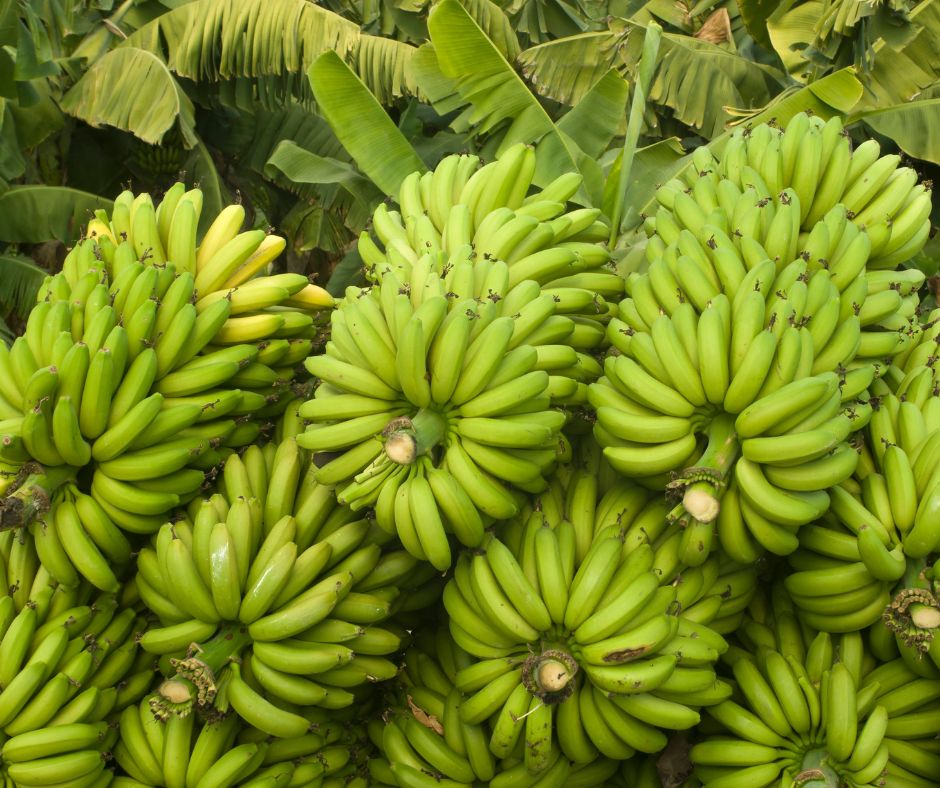
(Musa acuminata ‘Grand Nain’)
Another highly-productive banana plant, the Grand Nain is notable for its cold-hardiness, disease resistances, wind resistance, and manageable size. It’s also among the most sought after family of fruits, the ‘Cavendish’ group (same as Chiquita bananas). You’ll see these banana plants grown in containers or in-ground, and with great success in Louisiana!
Growth: 6-8 ft tall, 8-10 ft wideCold Hardiness: 15-20 degrees
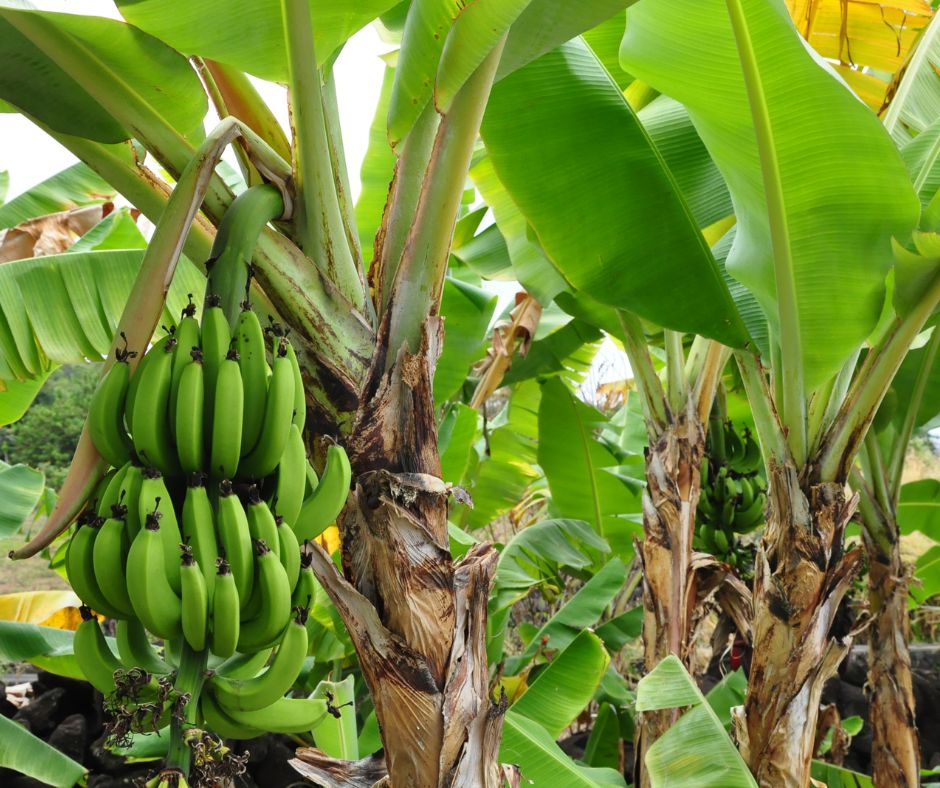
(Musa acuminata x balbisiana ‘Blue Java’)
Blue Java is a new selection at Louisiana Nursery, and we’re super excited! The name comes from it’s “vanilla ice cream flavored” fruit, and silvery-banana peels. However, the trait most important to us is a cold hardiness of 10-20 degrees! This is a game changer, as Louisiana gardeners may just finally get a consistent fruit even when planted in-ground. If easy-growing and ice-cream flavored bananas sounds good to you, give Blue Java a try!
Growth: 12-18 ft tall, 10-12 ft wideCold Hardiness: 10-20 degrees
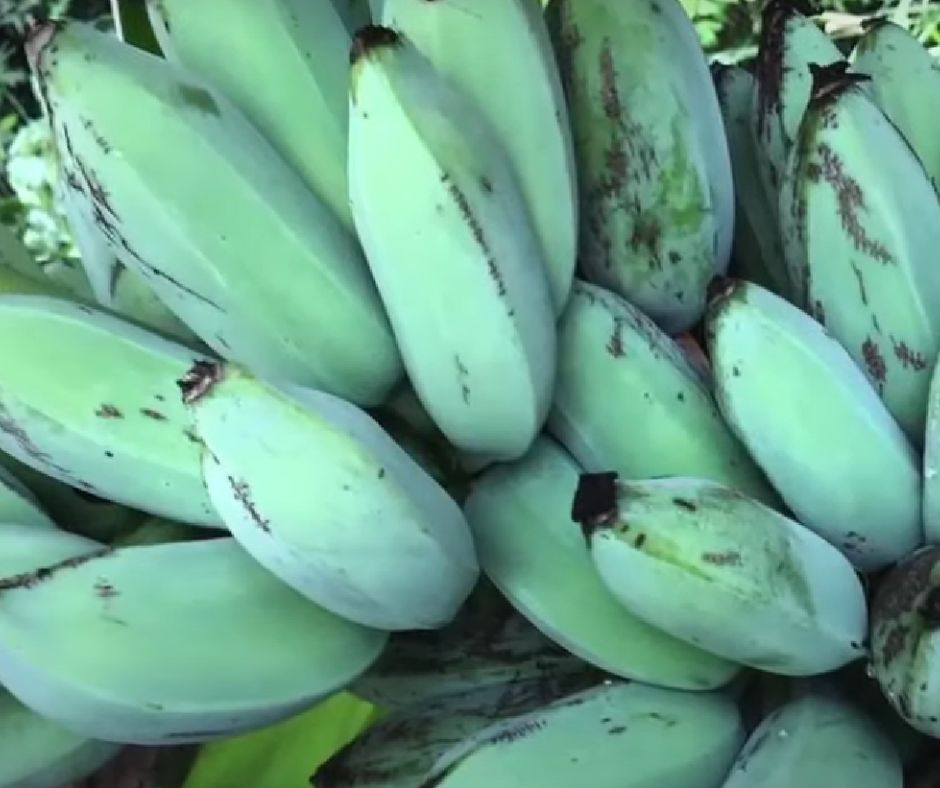
A mix between the Grand Nain ‘Chiquita’ banana and the ornamental Zebrina. Dwarf Sumatrana has excellent tasting, jungle-style fruit and a truly striking variegation of maroons and green. Sun-loving, fast-growing, all-around perfect choice for a Louisiana gardener. Even if this banana never made a fruit, you won’t regret seeing it in the yard.Growth: 7-10 ft tall, similar widthCold Hardiness: 30-40 degrees
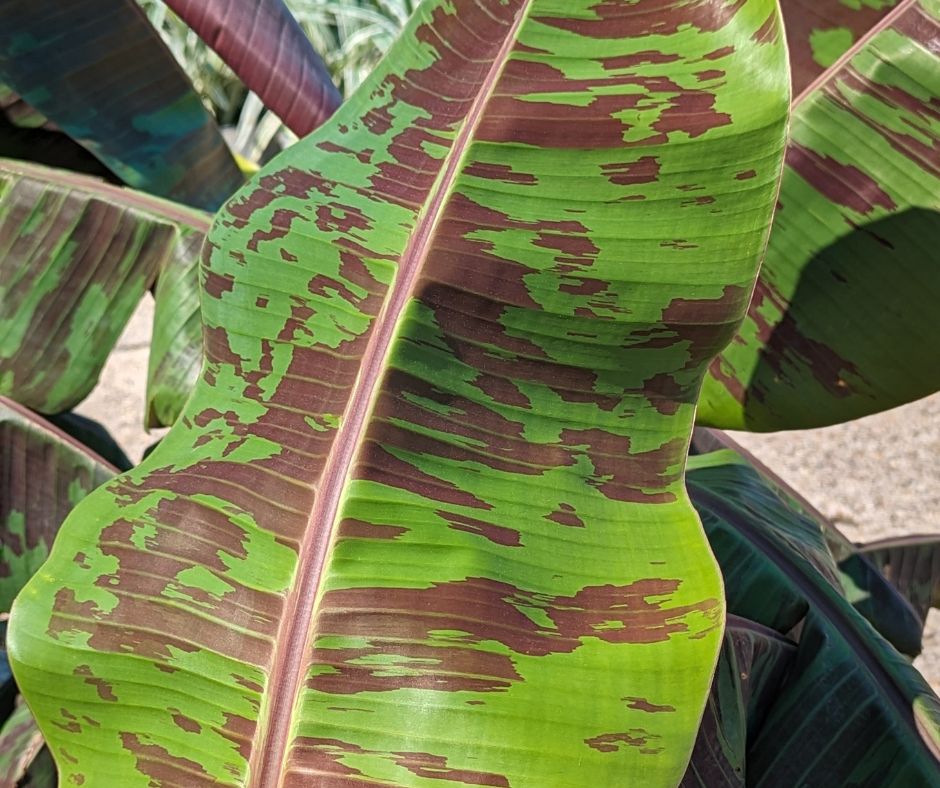
Choosing Landscaping Plants That Speak to You And Your Yard | Done-In-A-Weekend Projects: Layer Up
FAQ
Do banana leaf plants like sun or shade?
How big does a banana leaf plant get?
Do banana plants like full sun?
What size planter for a banana plant?
How big can a banana leaf plant grow?
A banana leaf plant can grow to different sizes depending on where it is grown. If you are caring for it indoors, it can grow to be 8-10 feet tall. If you are caring for it indoors, then it can grow to be 6-8 feet tall. Can I grow a Banana leaf plant indoors?
How big can a banana tree grow?
The largest banana plants can grow to be 30 feet tall (over nine meters) and 15 feet (four and a half meters) wide. No matter the ultimate size of the subspecies or cultivar you choose, banana plants are fast growers. Banana trees have large leaves — growing as many of 40 new ones during each growing season.
Can you grow banana leaves indoors?
You can grow a banana leaf plant indoors, but it usually takes a specific climate to grow efficiently. In the United States, banana plants are sold as specific types of house plants and can be expensive compared to other plant types. What can I do with Banana plant leaves?
Do banana leaf plants grow well?
In conclusion, growing banana leaf plants is an easy way to add an exotic touch to your outdoor garden. With proper care and attention, these beautiful plants can thrive in warm climates and provide years of enjoyment for you and your family.
